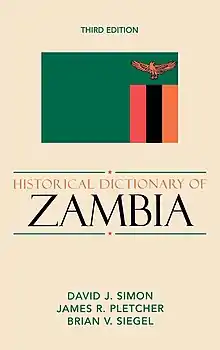Historical Dictionaries series
The Historical Dictionaries are a series of historical dictionaries published by Rowman & Littlefield that runs to hundreds of volumes. The first volumes in the series were published by Scarecrow Press from 1967 and were organised by country and continent, but the series has since expanded into a wide range of cultural and political topics. The dictionaries are arranged using a common structure and most have a single author. They seek to provide the historical context for current events.
 Historical Dictionary of Zambia, 3rd edition, Scarecrow Press, 2007. | |
| Founded | 1967 |
|---|---|
| Founder | Ralph R. Shaw |
| Country of origin | United States |
| Owner(s) | Rowman & Littlefield |
| Official website | https://rowman.com/page/hdseries |
Background
Scarecrow Press was founded by Ralph R. Shaw in 1950[1] to show that scholarly books could be published on a tight budget. One of its editors described it as a "bare-bones, quick-turnaround publisher which produced books for librarians and scholars. There were no book jackets, the covers were fairly ordinary, and the typesetting was not justified."[2]
History
The first books in the Historical Dictionary series were Latin American country volumes published in 1967. African and Asian countries followed in the 1970s, and lastly, European and Oceanic countries.[3] Later the series expanded into areas such as culture,[4] religion, and political philosophy.[5] There is a complementary series of Area Bibliographies.[2]
Most of the dictionaries have a single author, a practice described as "highly unusual" in dictionary compilation,[1] and Jon Woronoff, editor of the Asian series, has described the difficulty of finding suitable authors for some of the smaller countries, which meant that the African series, for instance, took 25 years to complete.[2] Once published, however, the volumes on the difficult countries potentially had more impact than those for which similar works already existed.[2]
The Scarecrow Press imprint was subsequently owned by Grolier and is now owned by Rowman & Littlefield. Selected volumes in the series are available in paperback as "A to Z Guides".[6]
Content
The dictionaries tend to follow a uniform format of a chronology, introduction, the historical dictionary, and a bibliography with supplementary material such as maps, abbreviations, place name changes, or notes on language according to the subject. The main section is the historical dictionary which covers events, people and places, and additional topics appropriate to the subject. The bibliographies are organised by subject and may range from 50 to 100 pages. Jon Woronoff has described the philosophy of the series as being to focus on current events with the historical content in the books limited to that necessary to understand those events. Other historical material is relegated to separate volumes on ancient history.[2][3]
Criticism
In his 1980 review article of the African volumes, David C. Tambo noted that the Historical Dictionaries had been subject to an unusually high level of criticism for a reference series. While librarians had lauded the works for filling a long-standing gap in the scholarly literature, academics complained about poor editorial choices, uneven quality, and a lack of factual accuracy. These failings were described as particularly regrettable where the volume covered a niche area for which a competing volume might never be produced. Tambo attributed the unevenness in quality to the practice of the publishers of using a single author for each volume, who often was not an historian, possibly in an attempt to save money. He concluded that although there was a need to collate this sort of material in one place, the African volumes reviewed had not met that need.[1]
Subjects
As of June 2019, dictionaries are published on the following subjects:[7]
- Africa
- The Americas
- Ancient Civilizations and Historical Eras
- Asia, Oceania, and the Middle East
- Cities, States, and Regions
- Diplomacy and Foreign Relations
- Discovery and Exploration
- Europe
- Intelligence and Counter-Intelligence
- International Organizations
- Literature and the Arts
- Peoples and Cultures
- Professions and Industries
- Religions, Philosophies, and Movements Series
- Sports
- U.S. Politics and Political Eras
- War, Revolution, and Civil Unrest
- Women in the World
See also
- Historical dictionary (a dictionary of word meanings on a historical basis)
- List of Scarecrow Press historical dictionaries
References
- "Review: African Historical Dictionaries in Perspective" by David C. Tambo, ASA Review of Books, Vol. 6 (1980), pp. 199–209. doi:10.2307/532665 – via JSTOR.
- "The 'Asian Historical Dictionary' Series", Jon Woronoff, IIAS Newsletter, No. 7 (Winter 1996).
- Historical Dictionary of Japanese Cinema, Review by Roger Macy, The Japan Society. Retrieved 12 June 2019. Archived 12 November 2017 at the Wayback Machine
- Mahony, Molly C. (1 July 2012). "A Review of "Historical Dictionary of Hobbes's Philosophy"". Journal of Religious & Theological Information. 11 (3–4): 169–170. doi:10.1080/10477845.2012.723596.
- The A to Z Guide Series. Rowman & Littlefield. Retrieved 12 June 2019.
- Historical Dictionaries Rowman & Littlefield. Retrieved 12 June 2019.